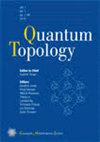扭转,突变和结花同源
IF 1
2区 数学
Q1 MATHEMATICS
引用次数: 9
摘要
设$\mathcal{L}$为具有固定正交叉的结,$\mathcal{L}_n$为用$n$正扭转代替该交叉得到的链接。证明了结花同调$\widehat{\text{HFK}}(\mathcal{L}_n)$在$n$趋于无穷时趋于稳定。这分类了一个类似的Alexander多项式的稳定现象。作为应用,我们构造了一个具有同构梯度结花同调群的无穷素数正突变结族。此外,对于任意一对正突变体,我们描述了如何推导出具有同构的等价$\widehat{\text{HFK}}$群、Seifert属和一致性不变量$\tau$的无限族正突变体。本文章由计算机程序翻译,如有差异,请以英文原文为准。
Twisting, mutation and knot Floer homology
Let $\mathcal{L}$ be a knot with a fixed positive crossing and $\mathcal{L}_n$ the link obtained by replacing this crossing with $n$ positive twists. We prove that the knot Floer homology $\widehat{\text{HFK}}(\mathcal{L}_n)$ `stabilizes' as $n$ goes to infinity. This categorifies a similar stabilization phenomenon of the Alexander polynomial. As an application, we construct an infinite family of prime, positive mutant knots with isomorphic bigraded knot Floer homology groups. Moreover, given any pair of positive mutants, we describe how to derive a corresponding infinite family positive mutants with isomorphic bigraded $\widehat{\text{HFK}}$ groups, Seifert genera, and concordance invariant $\tau$.
求助全文
通过发布文献求助,成功后即可免费获取论文全文。
去求助
来源期刊

Quantum Topology
Mathematics-Geometry and Topology
CiteScore
1.80
自引率
9.10%
发文量
8
期刊介绍:
Quantum Topology is a peer reviewed journal dedicated to publishing original research articles, short communications, and surveys in quantum topology and related areas of mathematics. Topics covered include in particular:
Low-dimensional Topology
Knot Theory
Jones Polynomial and Khovanov Homology
Topological Quantum Field Theory
Quantum Groups and Hopf Algebras
Mapping Class Groups and Teichmüller space
Categorification
Braid Groups and Braided Categories
Fusion Categories
Subfactors and Planar Algebras
Contact and Symplectic Topology
Topological Methods in Physics.
 求助内容:
求助内容: 应助结果提醒方式:
应助结果提醒方式:


